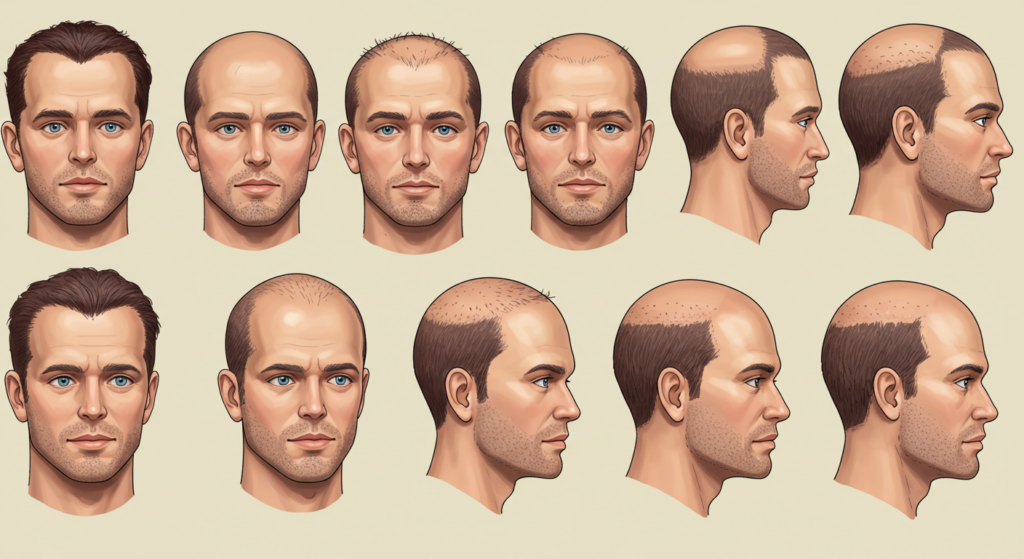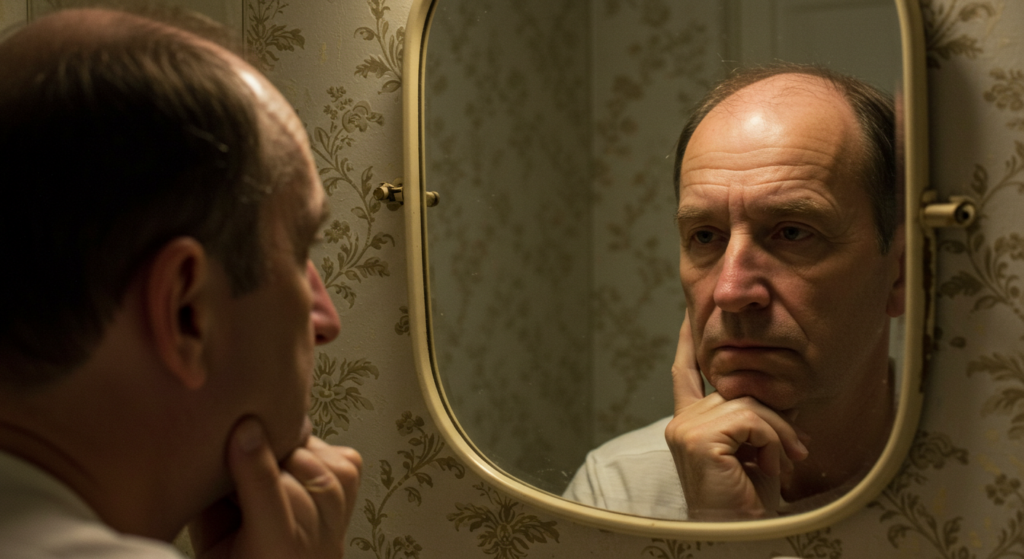La alopecia androgenética (AGA), comúnmente conocida como calvicie de patrón masculino, es una forma prevalente de pérdida de cabello que afecta a millones de personas en todo el mundo. Se caracteriza por un adelgazamiento gradual del cabello en el cuero cabelludo y suele seguir un patrón predecible, con retrocesos en las sienes y adelgazamiento en la coronilla. Comprender las causas subyacentes y las opciones de tratamiento disponibles es crucial para controlar esta afección y mitigar su impacto en la autoestima y la confianza. Este artículo explorará los factores genéticos y hormonales que contribuyen a la AGA y profundizará en los diversos métodos de tratamiento disponibles actualmente.

Entendiendo la alopecia androgenética
La alopecia androgenética es una afección progresiva, lo que significa que la pérdida de cabello empeora con el tiempo. No se trata solo de la pérdida de cabello, sino de la miniaturización de los folículos pilosos. Los folículos pilosos sanos producen cabellos gruesos y largos, mientras que los folículos miniaturizados producen cabellos finos y cortos, apenas visibles. Este proceso provoca el adelgazamiento y la recesión característicos de la AGA. La cronología y la gravedad de la pérdida de cabello varían significativamente entre personas, influenciadas por la genética y otros factores. El diagnóstico y la intervención tempranos a menudo pueden ralentizar la progresión y mejorar el pronóstico general.
El patrón de caída del cabello en la AGA es en gran medida predecible. En los hombres, suele comenzar con una línea de implantación capilar en retroceso en las sienes, a menudo descrita como una línea de implantación capilar en forma de "M". Esta recesión progresa gradualmente hacia arriba y hacia atrás, lo que puede provocar una pérdida significativa de cabello en la coronilla. En algunos casos, la caída del cabello puede ser difusa y afectar a todo el cuero cabelludo. El ritmo de progresión es variable: algunas personas experimentan una pérdida de cabello rápida, mientras que otras presentan un adelgazamiento más lento y gradual. Es importante destacar que la AGA no es un signo de una enfermedad subyacente, aunque puede ser una fuente de importante angustia psicológica.
Comprender las etapas de la AGA es útil para gestionar las expectativas y las estrategias de tratamiento. La escala de Norwood-Hamilton es un sistema de clasificación ampliamente utilizado que categoriza la extensión de la pérdida de cabello según patrones observables. Esta escala ayuda a los médicos a evaluar la gravedad de la afección y a adaptar los planes de tratamiento en consecuencia. La intervención temprana, incluso en las etapas iniciales, puede ser beneficiosa para ralentizar la progresión y preservar la mayor cantidad de cabello posible. El seguimiento y la comunicación regulares con un profesional de la salud... dermatólogo o un profesional de la salud son cruciales para una gestión eficaz.

Influencias genéticas y hormonales
Una fuerte predisposición genética es un factor principal en la alopecia androgenética. Diversos estudios han identificado múltiples genes asociados con un mayor riesgo de desarrollar AGA, lo que destaca la importante heredabilidad de esta afección. Si el padre o el tío materno de un hombre experimentaron una pérdida de cabello significativa, sus probabilidades de desarrollar AGA son considerablemente mayores. Sin embargo, la genética por sí sola no determina la aparición ni la gravedad de la pérdida de cabello; otros factores influyen.
El papel de los andrógenos, en particular la dihidrotestosterona (DHT), es fundamental en el desarrollo de la AGA. La DHT es una potente hormona derivada de la testosterona, y su interacción con los folículos pilosos es fundamental para el proceso de miniaturización. La DHT se une a los receptores del folículo piloso, lo que provoca un acortamiento del ciclo de crecimiento del cabello y, en última instancia, la producción de cabellos más finos y débiles. Este proceso es más pronunciado en personas con predisposición genética. La sensibilidad individual a la DHT varía, lo que explica las diferencias en la aparición y la gravedad de la AGA.
Además de la genética y la DHT, otros factores hormonales pueden contribuir a la AGA. Las fluctuaciones en los niveles de testosterona, los trastornos tiroideos y ciertos medicamentos pueden influir en el crecimiento del cabello y potencialmente exacerbar la caída del cabello. El estrés, la mala alimentación y las afecciones médicas subyacentes también pueden desempeñar un papel secundario, aunque su impacto directo en la AGA es menos conocido. Una historia clínica completa y una evaluación pueden ayudar a identificar cualquier factor contribuyente más allá de la genética y las hormonas.
Comprender la compleja interacción entre la genética y las hormonas es crucial para desarrollar estrategias de tratamiento eficaces. Dirigir la DHT, ya sea directa o indirectamente, sigue siendo fundamental en muchos tratamientos para la AGA. Sin embargo, para obtener resultados óptimos, suele ser necesario un enfoque holístico que considere los factores individuales y los posibles factores contribuyentes. Se siguen realizando investigaciones para explorar los mecanismos precisos implicados en la AGA e identificar posibles nuevas dianas terapéuticas.
Opciones de tratamiento disponibles hoy
Existen varias opciones de tratamiento eficaces para controlar la alopecia androgenética, desde medicamentos tópicos hasta procedimientos quirúrgicos. El minoxidil, una solución tópica, es un tratamiento de primera línea ampliamente utilizado. Se cree que prolonga la fase anágena (de crecimiento) del ciclo capilar y aumenta el flujo sanguíneo al cuero cabelludo. Si bien no cura el cabello, el minoxidil a menudo puede ralentizar la caída del cabello e incluso promover su recrecimiento en algunas personas. La aplicación constante es crucial para obtener resultados óptimos.
La finasterida es un medicamento oral que inhibe la conversión de testosterona en DHT, reduciendo así el impacto de esta hormona en los folículos pilosos. Generalmente, es más eficaz que el minoxidil para frenar la caída del cabello y promover su crecimiento, especialmente en hombres con AGA más avanzada. Sin embargo, es importante tener en cuenta que la finasterida conlleva posibles efectos secundarios, aunque estos suelen ser leves y temporales. Siempre se debe consultar a un médico antes de comenzar a tomar finasterida.
La cirugía de trasplante capilar es una opción más invasiva que consiste en trasplantar folículos pilosos de una zona donante (normalmente la parte posterior del cuero cabelludo) a zonas con adelgazamiento o calvicie. Este procedimiento puede ofrecer una solución permanente para la caída del cabello, pero es relativamente caro y requiere un período de recuperación. Los resultados suelen ser naturales, pero pueden variar según la persona. Es fundamental una cuidadosa consideración y una consulta con un cirujano cualificado.
Otras opciones de tratamiento incluyen la terapia láser de baja intensidad (LLLT), que utiliza láseres de baja intensidad para estimular el crecimiento del cabello. Si bien la evidencia que respalda su eficacia aún es incipiente, algunos estudios sugieren que puede ser beneficiosa al combinarse con otros tratamientos. La terapia con plasma rico en plaquetas (PRP) consiste en inyectar plaquetas concentradas de la propia sangre del paciente en el cuero cabelludo para estimular el crecimiento del folículo piloso. Se necesita más investigación para comprender plenamente su eficacia.
Manejo y prevención de la caída del cabello
Mantener un estilo de vida saludable puede ser crucial para la salud capilar y, potencialmente, para retrasar la progresión de la AGA. Una dieta equilibrada, rica en proteínas, vitaminas y minerales, es esencial para un crecimiento capilar óptimo. Asegurar una ingesta adecuada de hierro, zinc y biotina es especialmente importante, ya que las deficiencias de estos nutrientes pueden contribuir a la caída del cabello. El ejercicio regular mejora la salud general y la circulación sanguínea, lo que puede beneficiar indirectamente el crecimiento del cabello.
Controlar los niveles de estrés también es importante, ya que el estrés crónico puede afectar negativamente la salud capilar. Técnicas como el yoga, la meditación o pasar tiempo en la naturaleza pueden ayudar a reducir el estrés y promover la relajación. También es recomendable evitar productos capilares agresivos y prácticas de peinado que puedan dañar los folículos pilosos. Lavarse el cabello con suavidad y evitar el uso excesivo de calor para peinarlo puede ayudar a mantener la salud capilar y prevenir daños mayores.
Los masajes regulares del cuero cabelludo pueden mejorar la circulación sanguínea hacia los folículos pilosos, lo que podría promover el crecimiento del cabello. Realizar movimientos circulares suaves durante unos minutos al día puede ser beneficioso. Elegir los productos capilares adecuados también es importante. Optar por champús y acondicionadores suaves y sin sulfatos puede ayudar a prevenir la sequedad y el daño. Mantenerse hidratado bebiendo abundante agua también es crucial para la salud general, incluida la del cabello.
Si bien no existe una forma garantizada de prevenir por completo la alopecia androgenética, adoptar un estilo de vida saludable y controlar los posibles factores contribuyentes puede ayudar a ralentizar su progresión y a mantener la salud capilar durante el mayor tiempo posible. La intervención temprana con opciones de tratamiento adecuadas, combinada con un enfoque holístico del cuidado capilar, puede mejorar significativamente el pronóstico y mejorar la calidad de vida de las personas afectadas por AGA.
La alopecia androgenética es una afección común, pero no insuperable. Al comprender las causas subyacentes, explorar las opciones de tratamiento disponibles y adoptar un enfoque proactivo para el cuidado capilar y el bienestar general, las personas pueden controlar eficazmente la caída del cabello y mantener una imagen positiva de sí mismas. Consultar regularmente con un dermatólogo o un profesional de la salud es fundamental para obtener asesoramiento personalizado y estrategias de tratamiento. La información proporcionada en este artículo tiene fines educativos únicamente y no debe considerarse consejo médico. Siempre consulte a un profesional de la salud cualificado para el diagnóstico y tratamiento de cualquier afección médica.
Descubra la experiencia de la Dra. Ebru Okyay, su médico de confianza. dermatólogo en AntalyaYa sea que esté buscando abordar problemas médicos de la piel o mejorar su belleza natural con tratamientos cosméticos, el Dr. Okyay está aquí para ayudarlo. Con atención personalizada y técnicas avanzadas, lograr sus objetivos para la piel nunca ha sido tan fácil.
